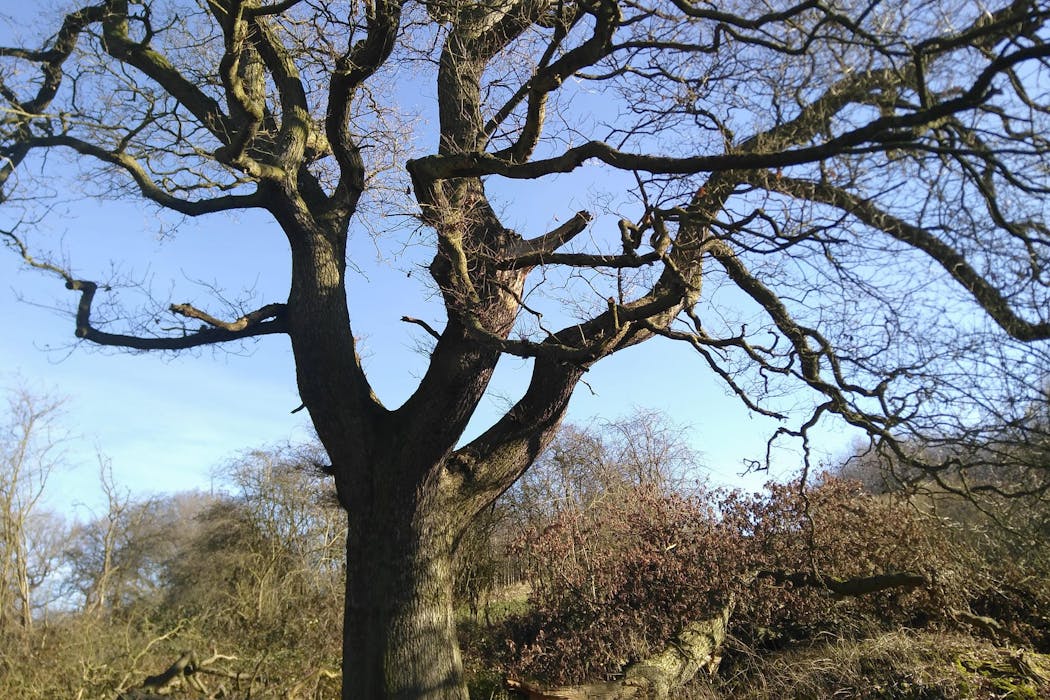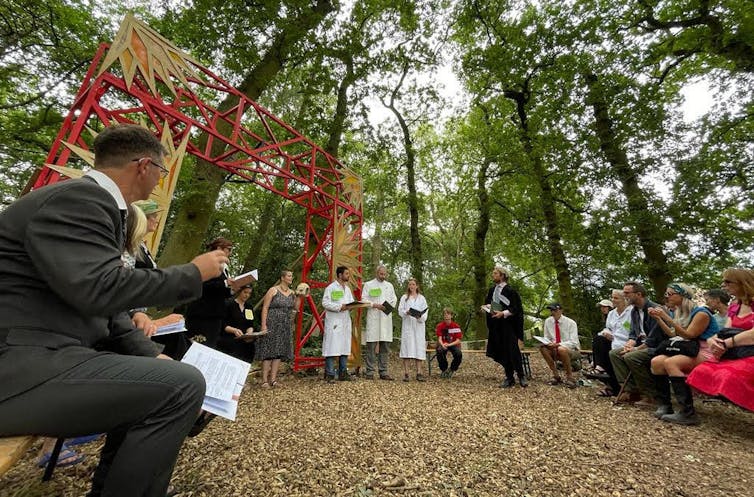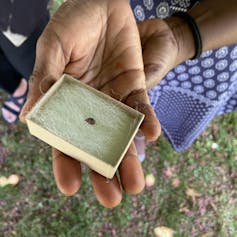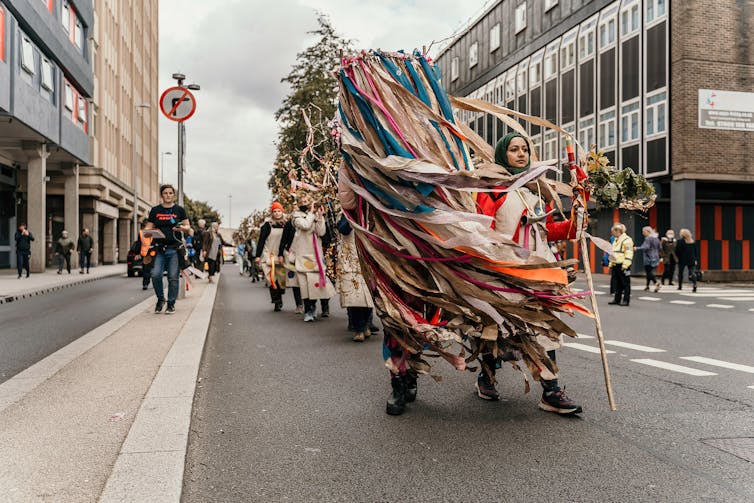Source: The Conversation – UK – By Estrella Luna-Diez, Associate Professor in Plant Pathology, School of Biosciences, University of Birmingham

The Feanedock Oak stands out so clearly in Derbyshire’s section of the National Forest, you’d think it was calling to you. Surrounded by open fields, hawthorn hedges and young beech forest, a majestic old oak like this anchors the English countryside.
As the highest expression of our woodlands, oaks support more life in the UK than any other native tree. At the foot of the Feanedock oak, you can hear and see – at a glance – wrens, blackbirds, spiders, squirrels, song thrush, hoverflies, butterflies, blackcaps, woodlouse, ants and chiffchaffs. For more than two centuries, it has provided an anchor habitat, including for humans – a tumbled-down dwelling lies under its shade.
How well any English oak (Quercus robur) thrives affects everything living on and around it, from canopy to soil. In recent years of heat and drought, the Feanedock Oak has lost two large boughs.
In the summer of 2023, dendrochronologists – who research and date trees through their growth rings – took samples from the tree’s trunk to study its “healthy” and “poor” years of growth. They counted 195 rings but did not get to the centre of the tree – so it was probably seeded in the early 19th century, if not earlier. As a sapling, it would have greeted Derbyshire miners walking across the fields from nearby villages to work in the newly-dug coal shafts or the many industrial potteries in the area.
More than 200 years later, in July 2023, the Feanedock Oak (now measuring around 120 feet) played a central role in Ring of Truth. This creative collaboration between tree scientists and artists from the Walking Forest collective imagined a legal case set in the year 2030 between a claimant, the oak (in whose shadow the case was heard), and the UK government.

RB Films, CC BY-NC-SA
The counsel for the claimant – real-life rights of nature lawyer Paul Powlesland – set out his argument to the judge and jury, claiming the government had breached legal obligations set out in the 2008 Climate Change Act. Scientists from the University of Birmingham – including one of us (Bruno) – acted as expert witnesses, bringing evidence of the threats posed to the tree from increased heat, atmospheric CO₂, soil damage and disease.
After hearing all the evidence, the assembled audience – in the role of jury – voted for their verdict. Many were acutely conscious that the claimant had been standing in this spot far longer than anyone else present – a silent witness to the damage done by humans on the environment and landscape. They ordered the secretary of state for climate and ecological breakdown (as the job is known in 2030) to cease breaching legal obligations to protect this and all “anchor oaks”, and the communities that thrive or suffer with them.
That powerful moment under the Feanedock Oak opened a door to a deeper question: how and what do trees remember?
Until recently, little was known about how memory might function in long-lived organisms like trees which experience decades, even centuries, of shifting environmental pressures. So this is what our multidisciplinary research collaboration – featuring artworks, performances and even a musical composition as well as groundbreaking science – set out to discover.
How trees’ memories work
For trees, memory is not a metaphor but a biological reality, written into their cells. One of the most remarkable forms this takes is epigenetic memory: the ability of a tree to record its life experiences and allow those experiences to shape its future, without changing the sequence of its DNA.
As Membra (full name: Understanding Memory of UK Treescapes for Better Resilience and Adaptation), we’ve studied a number of ecologically vital and culturally significant UK species including oak, ash, hazel, beech and birch. Together, they have helped us understand how trees register and respond to environmental stress, offering a powerful glimpse into how their memories are carried through woodlands.
At the heart of this process is DNA methylation, where chemical tags known as methyl groups are added to the tree’s DNA over time. While not rewriting the genetic code, they do alter how it is read. These chemical signatures can turn genes on or off, dial responses up or down, and fundamentally shift how a tree grows, adapts, or defends itself. In oaks, for example, long-term drought exposure over decades is associated with changes in DNA methylation, suggesting that trees may adjust their gene expression in response to repeated stress.
These epigenetic memories may allow trees to respond more quickly to drought, disease or climate extremes, and could even be passed to the next generation. In some plant species, this kind of inheritance is well documented, but in long-lived trees, it remains an open question – one with critical implications for forest regeneration and resilience.
The Insights section is committed to high-quality longform journalism. Our editors work with academics from many different backgrounds who are tackling a wide range of societal and scientific challenges.
So far, our research has shown trees respond to stress in ways that can extend well beyond the immediate event. Exposure to drought or high CO₂, for example, can leave lasting marks on a tree’s growth and internal chemistry, and may shape how it responds to future conditions. But the strength of this memory appears to depend on the nature of the stress: it is more pronounced when the stress is particularly strong, such as disease, or when it occurs repeatedly over time, such as chronic drought.
A surprising result came from oak, where we observed that DNA methylation itself changes depending on the time of year – with methylation levels lowest in early spring, then increasing as the seasons progress. This suggests the imprinting of memory in trees may be far more dynamic than previously thought, and that the timing of stress events within the growing season could influence how strongly that memory is encoded.
All our studied species and associated environmental conditions have now been sequenced. In every case, we have found evidence of these memories of past stresses. In ash trees, for example, we’ve begun to detect methylation changes linked to ash dieback pressure, offering clues as to how trees regulate their defences over time as a disease progresses.
Trees are certainly resilient. They bend, adapt and endure, holding the memory of storms and seasons within their very bodies. But even their deep-rooted strength has limits. The challenges they now face are faster, more frequent and more severe than at any point in their evolutionary history.
This means what we are learning from their memories is not just a story of survival, but a warning. They are telling us there could come a point when they can no longer cope.
Even young trees remember
It is easy to be awed by a centuries-old oak. But what often goes unnoticed is the quiet crisis beneath the canopy. Across many UK woodlands, the next generation is missing.
Surveys show steep declines in most species of young trees (seedlings and saplings) due to a growing list of pressures: prolonged drought, warming temperatures, shifting herbivore populations, and an expanding wave of pests and pathogens. According to a study of nine sites in England and Scotland, co-authored by one of us (Bruno) and currently under review, the sapling mortality rate has increased from 16.2% in the period up to 2000 to 30.9% two decades later.
In some species such as elm and now ash, diseases have brought populations close to the point of lack of regeneration – when a woodland can no longer sustain itself. To counter this threat, young trees must be highly adaptable – not just in form, but at the molecular level. At Membra, scientists are exploring whether young trees imprint environmental stress more readily than older ones, and whether that memory, recorded through changes in DNA methylation, influences their survival.
One way we have tested such transgenerational changes is to expose trees (oak and hazel) to the elevated levels of CO₂ that are expected in the UK by 2050. This was done in the Birmingham Institute for Forest Research (Bifor) facility in a Staffordshire woodland – one of the world’s largest climate change experiments, where tree “arrays” (circular patches of woodland) are exposed to 150 parts per million (ppm) of CO₂ above ambient concentrations.
Membra’s research there has found that the offspring of trees exposed to these CO₂ levels respond very differently to further environmental stressors – in ways that can make them more resilient. For example, acorns from CO₂-exposed oaks were notably larger and their seedlings showed both faster growth and improved resistance to pathogens like powdery mildew – a strong sign that environmental conditions experienced by parent trees can shape offspring resilience.
To date, molecular analysis shows the inherited memory of this exposure is imprinted in the tree genes that are involved in defence mechanisms. The direct link with resilience should be identified in the next few years as our data analysis progresses.
Strikingly, these beneficial effects were most pronounced during “mast” years, when trees produce a bumper crop of seeds, suggesting that the reproductive cycles of mature oaks as well as resource availability are key to the oaks’ successful inheritance of stress-adaptive traits. Similarly, seedlings from oak trees that had undergone repeated drought exposure have shown increased drought tolerance – which suggests some trees may “prime” their offspring to be more resilient in the face of repeated climate stress.
Our work also shows that young trees can be artificially primed for resilience. For instance, early treatment with certain natural compounds enhances oak seedlings’ resistance to powdery mildew disease, triggering biochemical and transcriptional responses that allow them to mount a faster and stronger defence. This priming acts like a kind of immunological memory – in this case not inherited but induced – and could potentially open up new avenues for improving forest health and regeneration.
Importantly, species differ widely in how they pass on environmental experiences to their progeny. Hazel trees subjected to the same elevated CO₂ conditions in the Bifor woodland produced both smaller nuts and seedlings that often failed to thrive after germination. So, rather than assuming a one-size-fits-all strategy for seed sourcing, forestry managers may need to tailor decisions based on species-specific responses to past environmental stresses. Recognising the importance of parental environmental history, especially for stressors like drought, could shape how we select and prepare the next generation of trees.
This may also mean rethinking how and when we collect seeds. In species such as oak, collecting from mast years may improve the odds of transmitting beneficial adaptive traits. In all cases, understanding how trees’ memory works, not just within a tree’s lifetime but across generations, offers a crucial tool for building more adaptive, resilient treescapes in this rapidly changing world.

Lucy Neal/Walking Forest, CC BY-NC-SA
Using trees’ memories to plant for the future
Tree rings such as those sampled from the Feanedock Oak record much more than just a tree’s age. They hold evidence of how trees respond to changing climates, rising carbon levels and extreme events.
Studies using these natural archives (the rings) have shown that rising atmospheric CO₂ is already changing how trees grow and photosynthesise. In some oaks, it has led to faster growth and more carbon being stored – a hopeful sign.
But this acceleration may come with hidden costs. Trees that grow quickly not only reach maturity sooner but may also die younger, potentially limiting the long-term stability of forest carbon storage.
And these shifts are not just a concern for the trees themselves – they ripple outward. Faster growth can alter forest structure, affecting biodiversity and resilience. In the UK and globally, trees face an escalating cascade of challenges including pollution, drought, storms and disease – and increasingly, these pressures overlap.
Understanding how different trees’ memories will mediate their responses to new, more stressful conditions is key to predicting which species will thrive, adapt or decline. Artificially priming young trees by exposing them early to stress may enhance their memory and survival.
Read more:
How plants are able to remember stress without a brain
In recent years, a wave of tree planting, often tied to carbon offsetting schemes, is rapidly reshaping landscapes across much of the UK. National and local governments have launched large-scale initiatives such as the England Tree Action Plan. These programmes aim to restore canopy cover, improve biodiversity and contribute to net-zero goals. Local authorities, environmental charities, landowners and corporate offsetting partners are among those overseeing the planting, with guidance and funding provided by the Forestry Commission and Defra.
However, the choice of species is often constrained by budget and availability, which can result in limited diversity and mismatches between trees and local ecological conditions. Fast-growing species like sycamore, alder, and hybrid poplar are frequently used, while slower-growing native species with deeper ecological value may be underrepresented.
Planting trees without understanding their long-term ecological roles – or their capacity to remember and adapt – also risks repeating old mistakes that could compromise long-term resilience. Selecting the right trees to face future climate threats requires more than just numbers. A forest full of fast-growing, short-lived trees may have a very different effect on the local ecosystem than one with long-lived, memory-bearing individuals. In the worst-case scenario, such woodlands will fail to regenerate and die out.
Climate models indicate a future of warmer, wetter winters and hotter, drier summers in the UK, which will challenge many native species. Diseases such as ash dieback have already transformed landscapes, with over 80% of ash trees expected to be lost in many areas. This is not just a loss of a species but a loss of the biodiversity that depends on it.
Our work highlights the value of sourcing seed from trees that have survived historic drought and understanding how memory, resilience and adaptation are embedded in the biology of many older individuals. Future woodlands will need to blend ancient wisdom with modern science, combining genetic diversity, environmental memory and community stewardship to thrive.
Trees have rights
The idea that nature has rights is no longer just a philosophical concept. Legal recognition is growing globally, from Ecuador’s Constitutional Court ruling to protect the Los Cedros forest, to the Welsh National Assembly’s creation of the Well-being of Future Generations Act and UK-based cosmetics company, Faith in Nature, giving nature a legal position on its board.
This legal shift complements the scientific insight from Membra: that mature woodlands, with deep memory and biodiversity, are not replaceable. And as Ring of Truth’s imagined court case made clear, it is a travesty if trees such as the Feanedock Oak are thought of as little more than machines to extract human-created carbon from the atmosphere.
Their social, cultural and ecological roles are vast. Listening to Indigenous and local communities with long-held tree knowledge, and empowering tree guardians in cities and villages alike, is vital to fostering a meaningful public practice of tree stewardship.
As one Walking Forest participant put it, time spent with trees creates space and renewed agency for surviving the climate and nature crises: “We are like trees. The stronger we root and allow ourselves, like them, to be nurtured by those around us, the better we are at withstanding the strongest of storms”.
Another said: “I see the bigger picture now, of how we are related to the forest – at one with nature because we too are part of the ecosystem.”
By weaving together artistic performance, scientific insight and ancestral knowledge, the Walking Forest collective has sought to expand how we understand our relationship with woodlands – connecting women, trees and ecological justice across time.
One powerful example is the 107-year-old Monterey Pine planted by suffragette Rose Lamartine Yates, the last known survivor of a historic arboretum planted by women activists at Eagle House in Batheaston, Somerset. A place of recovery for women who were politically active as part of the suffrage movement, this was the home of the Blathwayt family – and known as the Suffragettes’ Retreat.

Linley Blathwayt/Wikimedia
Between April 1909 and July 1911, at least 47 trees were planted in the grounds of Eagle House to commemorate individual suffragists and suffragettes, many of whom had been imprisoned and tortured. The arboretum afforded the suffragettes an opportunity to imagine the future into which their young trees would grow.
The trees were all bulldozed in the late 1960s to make way for a housing estate – other than Lamartine Yates’s Monterey Pine, planted in 1909, which survives to this day, protected in a private garden. The seeds of this tree are a touchstone of Walking Forest: we have gathered and propagated them, shared them with communities, and created performances and ceremonies that honour the tree’s legacy – connecting past and future generations (of trees and people) in a project to create a woodland that mirrors the original Eagle House arboretum.

Walking Forest, CC BY-NC-SA
Since 2018, Walking Forest artists have travelled overland to UN climate talks to gift seeds from the Monterey Pine to women and youth activists, climate negotiators, Indigenous community leaders and environmental campaigners – connecting with them in this story of resilience and renewal.
In another act of collective mourning and protest, a 100-year-old silver birch cut down for the HS2 rail link was carried through Coventry by more than 40 women during Coventry’s year as City of Culture in 2021. The act made visible the loss of ancient woodland and connected it with human grief, resistance and care.
These stories are not isolated. Across the UK, trees have become flashpoints for protest and protection – from the Sycamore Gap tree at Hadrian’s Wall to Sheffield Council’s felling of more than 5,000 healthy street trees between 2014 and 2018 as part of road maintenance.
Read more:
The Sycamore Gap: four other significant tree destructions from history
Walking Forest has collaborated with Membra not only to share scientific knowledge but to offer new ways of knowing through storytelling, ritual and creative action. As climate pressures grow, so too does public awareness of how irreplaceable mature trees are.

Oana Catalina Necsulescu/Walking Forest, CC BY-NC-SA
What future research could reveal
We are still only beginning to uncover the complexity of tree memory. Future research may reveal exactly how memory is transferred between generations, how trees prepare for challenges they’ve never seen, and how entire forests might adapt together.
But our collaboration between scientists, artists and communities is already helping to shift how people think about trees, from passive backdrop to learning beings. Through this work, we understand that trees are not just survivors – they are storytellers, record keepers and even teachers.
As our understanding of their memory deepens, so too does our responsibility to listen, learn and act. The future of forests depends not just on what trees can remember, but on what we choose not to forget.
A recent return to the Feanedock Oak, two years after its case was argued in Ring of Truth, found the tree still standing but visibly altered. Its two large, fallen limbs lay cloaked in bramble and nettle. But under its canopy, foxes burrowed, birds sang and fruit trees flowered.
Though imbalanced, this grand old oak holds its ground – a tree of memory and now a symbol of care. We will return again and again to honour its survival, and admire its provision for so many other species in the natural world. The tree reminds us that people need ways to anchor ourselves too, as we navigate uncertain times ahead.
For you: more from our Insights series:
![]()
Estrella Luna-Diez receives funding from UK Research & Innovation (UKRI) and the Natural Environment Research Council (NERC).
Anne-Marie Culhane receives funding from UKRI and the NERC.
Bruno Barcante Ladvocat Cintra receives funding from the NERC.
Additional thanks to Lucy Neal, member of the Walking Forest collective, for her written and photographic contributions to this article. Lucy was the creator of Ring of Truth, performed at the Timber Festival in July 2023.
– ref. What do trees remember? Our research reveals trauma and hope hidden in their memories – https://theconversation.com/what-do-trees-remember-our-research-reveals-trauma-and-hope-hidden-in-their-memories-268499




